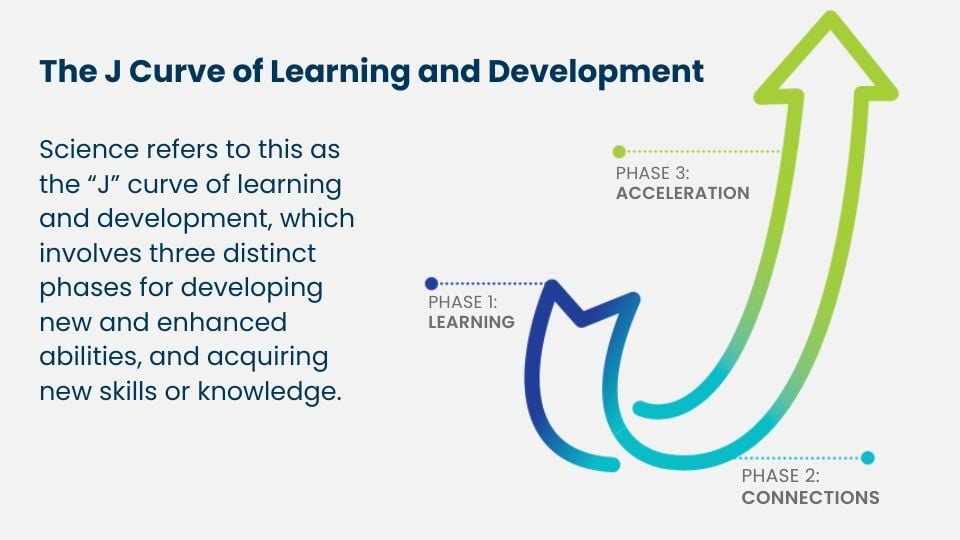Progress is Not a Straight Line
As parents, it’s rewarding to witness our children grow in confidence, independence, and capability—whether they’re mastering math facts, learning to ride a bike, managing big emotions, or finding their voice in social settings. But sometimes, it can feel like your child is stuck—or even going backward—despite their effort. It can be confusing, even disheartening, especially when you’re trying to support them the best you can.
The truth is, growth doesn’t always happen in a straight line.
At Brain Balance, we work with kids, teens, and young adults of all abilities, and we consistently see a pattern to real, lasting progress—what science refers to as the J Curve of Learning and Development. This framework helps explain why things often feel harder before they get better, and why persistence during the hardest parts of growth is so critical to long-term success.
The Three Phases of the J Curve

Phase 1 - The Cognitive Phase: Learning Something New
This is where the journey begins. Your child is trying something they haven’t done before—or trying to do something familiar in a new way. It could be a 6-year-old learning to tie their shoes, a 10-year-old learning to write a structured paragraph, a teen building time-management skills, or a young adult working on emotional regulation. In this stage, the brain is working overtime to understand what’s being asked and how to execute it. New information is being processed, and new connections are forming—but it requires intense focus, energy, and mental effort to get there.
What this looks like: Excitement is often mixed with hesitation. You may hear “This is too hard,” or “I don’t get it.” Younger kids may avoid the task altogether, while teens may procrastinate or become discouraged. A young adult may feel overwhelmed trying to juggle new responsibilities like managing a schedule or holding a part-time job.
Support Tip: Focus on the goal and celebrate effort, not perfection. Reinforce the idea that starting something new is always the hardest part—and that every step forward counts.
Phase 2 -The Connection Phase: Practice and Progress
This is the messy middle. Your child has learned the basics, but they haven’t mastered the skill yet. Now it’s about repetition and practice. A second grader may need to read aloud every day to build fluency. A middle schooler working on social confidence might need to initiate small conversations again and again. A teen with ADHD might be practicing strategies to stay organized, while a young adult in college might be learning how to advocate for themselves with professors. This is the most frustrating stage for many families because the effort is high, but visible progress may feel low.
What this looks like: Children may seem more tired, discouraged, or resistant. Parents may notice an increase in avoidance behaviors, emotional outbursts, or negative self-talk. Even when your child is showing up and trying, you might feel like you’re repeating the same lessons or reminders daily.
Support Tip: This is where the brain is doing the heavy lifting. Stay consistent, keep the routine predictable, and offer encouragement through the dip. Remind your child (and yourself) that feeling stuck is often a sign that real progress is just around the corner.
Phase 3 -The Automation & Acceleration Phase: Growth Takes Off
This is the point where everything clicks. After putting in the work, the brain now completes the task more efficiently and automatically. A younger child suddenly reads a book independently. A teen begins turning in homework without constant reminders. A young adult facing anxiety starts using coping strategies successfully in real-life situations. The skill that once required full focus is now being used with ease and confidence.
What this looks like: Improved outcomes with less effort. You may see better behavior, stronger self-esteem, more independence, or faster learning. Your child might even begin enjoying the tasks that once caused stress. You’ll likely notice a ripple effect, where gains in one area start boosting confidence and performance in others.
Support Tip: Celebrate this phase! Acknowledge how far your child has come, and let them take pride in their progress. This success builds resilience and reinforces the belief that growth is possible and repeatable.
How Brain Balance Supports Every Phase
The Brain Balance Program is built around the science of how the brain learns and adapts. Our multi-modal approach activates and strengthens the brain systems involved in attention, executive function, learning, behavior, social-emotional growth, and more. Through personalized in-center sessions and at-home support, we help kids move through each phase of the J Curve—from learning to mastering to thriving.
Whether your child is struggling to follow directions, maintain friendships, stay focused in school, or regulate their emotions, we don’t just work on the surface skills—we build the foundational brain connections that make progress possible.
Print this free J Curve of Development Guide to help keep your confidence while helping your child work through new stages of growth
Final Thoughts
If your child is in a challenging phase right now, they might be exactly where they need to be: building the brainpower to push through the dip and rise toward independence, confidence, and success.
Growth is not always obvious in the moment, but that doesn’t mean it isn’t happening.
Stay consistent. Keep practicing. The best is yet to come.
Learn More
Want to know how Brain Balance uses movement to improve your child’s focus, behavior, and learning? Learn more about our whole-brain, movement-based approach.